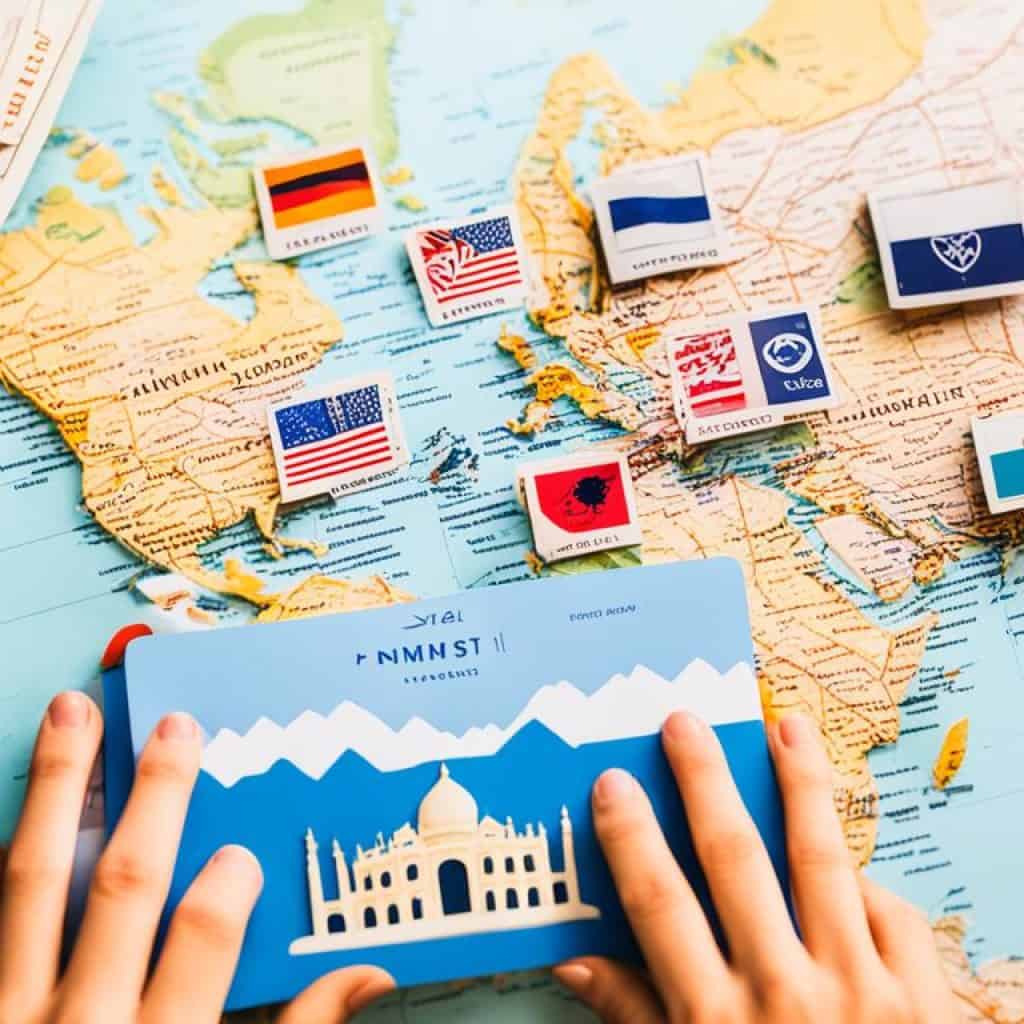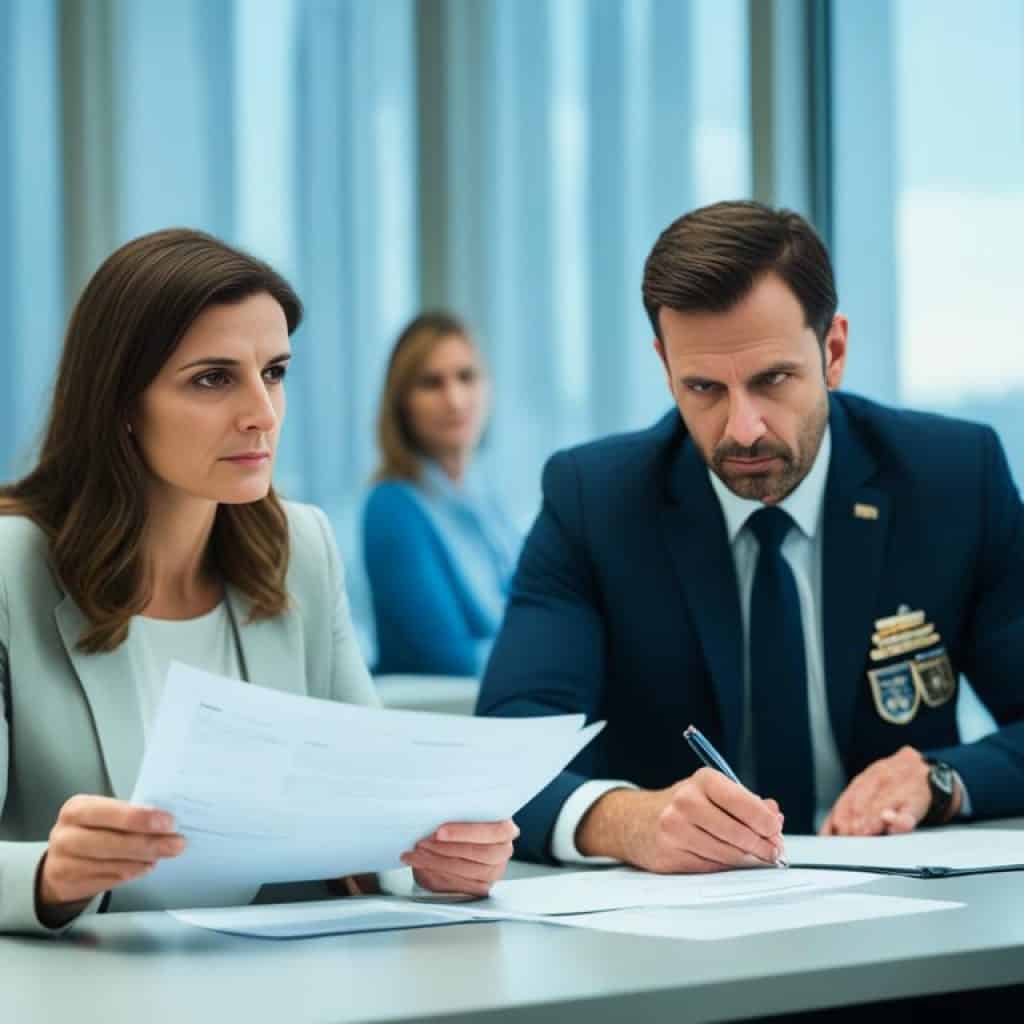Are you eagerly waiting for the arrival of your fiancé(e) to the United States? Wondering how long the process will take and what steps you need to follow? Discover the comprehensive K1 visa timeline and unlock the path to your loved one’s dream of joining you in the US.
- Obtaining a K1 visa typically takes around 6 months on average.
- The cost to apply for a K1 visa is $800, which includes government fees and additional expenses.
- Meeting the eligibility requirements, including being a U.S. citizen and having a genuine relationship, is crucial.
- The K1 visa application process involves filing Form I-129F, attending an interview, and getting married within 90 days of arrival.
- After marriage, the final step is applying for a marriage-based green card.
Understanding the K1 Visa Processing Time
When it comes to the K1 visa application process, understanding the processing time is crucial for planning your future with your fiancé(e). The K1 visa processing time refers to the duration it takes for your application to be reviewed and approved or denied by the United States Citizenship and Immigration Services (USCIS).
Based on analysis by Boundless partner Track My Visa Now, the average processing time for a K1 visa application, also known as Form I-129F, is around 6 months. However, it’s important to note that individual processing times may vary depending on various factors.
Once your Form I-129F is approved, USCIS will forward your case to the National Visa Center (NVC) for further processing. This transition typically takes between four to six weeks. It’s important to remain patient during this time and await further instructions from the NVC.
To ensure a smooth process, it’s crucial to carefully follow the instructions provided by USCIS and submit all required documentation in a timely manner. By doing so, you can help expedite the processing time and increase your chances of a successful outcome.
K1 Visa Processing Time: Key Points
- The average processing time for a K1 visa application is approximately 6 months.
- Individual processing times may vary based on various factors.
- After Form I-129F is approved, it takes between four to six weeks for the case to be forwarded to the National Visa Center (NVC).
- Following USCIS instructions and submitting all required documentation promptly can help expedite the processing time.
Having a clear understanding of the K1 visa processing time can help you plan your future with your fiancé(e) and make necessary arrangements. While the process may seem complex, staying informed and following the guidelines provided by USCIS can increase the likelihood of a successful outcome. Patience, persistence, and attention to detail are key throughout the K1 visa application process.
The Cost of the K1 Visa
When applying for a K-1 fiancé visa, it’s important to understand the associated costs. The total cost for a K-1 visa amounts to $800, which includes various fees and expenses.
Government Fees
The government requires a fee of $535 for Form I-129F, the petition for Alien Fiancé(e). This fee covers the processing and review of your application by the United States Citizenship and Immigration Services (USCIS).
Medical Exam Fee
As part of the visa application process, the foreign fiancé(e) is required to undergo a medical examination by a certified physician. The cost of the medical exam typically ranges around $200.
Visa Application Fee
There is a fee of $265 for the K-1 visa application itself. This fee is paid to the U.S. Department of State and covers the administrative processing of your visa application.
It’s worth noting that these fees are subject to change, so it’s important to check the latest fee schedule provided by the USCIS and the U.S. Department of State.
Additional Costs
In addition to the government and medical fees, there may be other costs associated with the K-1 visa application process. These can include document translations, photocopying, and obtaining any required supporting documents such as birth certificates or divorce decrees. It’s recommended to budget for these additional expenses as they can vary depending on individual circumstances.
By understanding the costs involved in the K-1 visa application process, you can better plan and budget for a successful journey towards your fiancé(e)’s arrival in the United States.
Meeting the Eligibility Requirements for a K1 Visa
Obtaining a K-1 fiancé visa requires meeting certain eligibility requirements. It is important to understand and fulfill these requirements to ensure a smooth and successful application process.
To be eligible for a K1 visa, both partners must meet the following criteria:
- The sponsoring fiancé must be a U.S. citizen.
- Both partners must be unmarried and in a genuine relationship.
- They must have met in person at least once within the two years before filing the petition.
- Both partners must have the intention to marry within 90 days of the foreign fiancé’s arrival in the U.S.
- The U.S. citizen sponsor must meet the income requirements of at least 100% of the Federal Poverty Guidelines.
Meeting these requirements is essential for a successful K1 visa application. It is necessary to provide evidence of the in-person meeting, such as travel documents, photographs, and other supporting documents that demonstrate the authenticity of the relationship.
It is also important for the sponsoring fiancé to meet the income requirements as specified by the Federal Poverty Guidelines. This ensures that the U.S. citizen sponsor can financially support the foreign fiancé upon their arrival in the U.S.
Remember: Meeting the eligibility requirements is just the first step in the K1 visa process. It is important to gather all necessary documentation and thoroughly prepare for the application to increase the chances of a successful outcome.

Filing Form I-129F
The first step in the K1 visa application process is to file Form I-129F with USCIS. This form is used to establish your eligibility to sponsor your foreign fiancé(e) for a K1 visa. It is crucial to provide accurate and detailed information, as well as strong evidence of your bona fide relationship. This includes documents such as photographs together, plane tickets, and correspondence.
National Visa Center (NVC) Processing
Once your Form I-129F is approved by USCIS, the case will be forwarded to the National Visa Center (NVC). The NVC will conduct additional background checks and process your case for further review. During this stage, you may be required to submit additional supporting documents as requested by the NVC.
Completing the DS-160 Form
After the NVC completes its processing, your foreign fiancé(e) will be notified to complete the DS-160 form. This form is an application for a nonimmigrant visa and provides detailed information about the applicant. It is important to accurately fill out this form and provide all necessary documents as required.
Attending the Visa Interview
Once the DS-160 form is completed, your fiancé(e) will be scheduled for a visa interview at the nearest U.S. Embassy or Consulate in their home country. The interview is a crucial step in the application process and allows the consular officer to determine whether your relationship is genuine and whether you meet the eligibility criteria for a K1 visa. It is important to prepare for the interview by reviewing possible questions and gathering supporting documents.
Arriving in the U.S. and Marriage
Upon approval of the K1 visa, your fiancé(e) will be able to travel to the United States. It is important to note that once they arrive in the U.S., you must get married within 90 days. Failure to do so may result in the termination of the K1 visa and potential immigration consequences. Plan your wedding accordingly to ensure compliance with this requirement.
| Step | Description |
|---|---|
| 1 | File Form I-129F with USCIS, providing proof of relationship and meeting in person. |
| 2 | Case forwarded to the National Visa Center (NVC) for processing and additional review. |
| 3 | Foreign fiancé(e) completes the DS-160 form and submits necessary documents. |
| 4 | Attend the visa interview at the U.S. Embassy or Consulate in the foreign fiancé(e)’s home country. |
| 5 | Upon approval, the fiancé(e) can travel to the U.S. and must get married within 90 days. |
Understanding the K1 Visa Denial Rate
When applying for a K1 visa, it’s essential to understand the K1 visa denial rate and the potential reasons behind it. In the fiscal year 2022, USCIS received a total of 48,118 applications for Form I-129F, out of which 9,492 were denied. This means that the K1 visa denial rate was 19.7%.
There are several factors that can contribute to a K1 visa application being rejected. One common reason is incomplete documentation. It is crucial to carefully review the application instructions and ensure that all required documents are provided in the correct format.
Another reason for denial is the failure to meet eligibility requirements. To qualify for a K1 visa, both the sponsoring fiancé and the foreign fiancé must meet specific criteria. These criteria include being unmarried, having a genuine relationship, and having met in person within the two years preceding the application.
Suspicion of fraud can also lead to the denial of a K1 visa application. USCIS closely examines applications to detect any signs of fraudulent activity. Providing accurate and truthful information, along with supporting evidence, is crucial to avoid suspicion.
To increase your chances of approval, it is essential to carefully follow the application instructions and submit all necessary evidence. Be thorough in gathering all required documentation, including proof of relationship and meeting in person. By providing complete and accurate information, you can mitigate the risk of a K1 visa denial.
Common Reasons for K1 Visa Denials:
- Incomplete documentation
- Failure to meet eligibility requirements
- Suspicion of fraud
Reasons for K1 Visa Denial Rate:
| Denial Factors | Number of Denials |
|---|---|
| Incomplete documentation | 4,512 |
| Failure to meet eligibility requirements | 3,153 |
| Suspicion of fraud | 1,827 |
Understanding the K1 visa denial rate and the reasons behind it can help applicants prepare a strong and comprehensive application. By addressing potential concerns and providing all necessary evidence, you can increase your chances of a successful K1 visa approval.
The Importance of the 2-Year Rule in the K1 Visa Process
The 2-year rule is a crucial aspect of the K-1 visa process for couples seeking to bring their fiancé(e) to the United States. This rule requires the couple to provide proof that they have met in person at least once within the two years before submitting Form I-129F, the petition for a K-1 visa.
Meeting in person is an essential requirement to validate the authenticity of the relationship. It helps confirm that the couple has a genuine intention to get married and ensures that they have spent quality time together to build a strong foundation for their future. Online meetings, video chats, and phone calls do not meet the criteria for satisfying the 2-year rule.
The 2-year rule was implemented to prevent fraudulent applications and to prioritize genuine relationships. It demonstrates that the couple has taken the necessary steps to establish a physical connection, which is vital for a successful marriage-based immigration process.
That being said, there are exceptions to this rule in certain circumstances. Religious or cultural traditions that prohibit in-person meetings may be considered valid reasons for waiving the 2-year requirement. Additionally, cases of severe hardship that prevent the couple from meeting in person may also be eligible for an exception.
Understanding the Two-Year Meeting Requirement
The 2-year rule is strictly enforced by the United States Citizenship and Immigration Services (USCIS). To meet the requirement, the couple must provide evidence of their in-person meetings, such as travel itineraries, copies of plane tickets, hotel reservations, photographs together, and any other supporting documentation that establishes their physical presence in each other’s company.
It’s crucial to maintain a record of all the meetings and keep documentation organized during the application process. This will help ensure a smooth and successful K-1 visa application.
The Impact of the 2-Year Rule on the K1 Visa Timeline
The 2-year rule significantly affects the overall timeline of the K-1 visa application process. Couples must factor in the time it takes to meet in person within the two-year timeframe before submitting Form I-129F. Failing to meet this requirement can lead to delays or even the denial of the visa application.
To avoid unnecessary setbacks, it’s essential to plan and schedule in-person meetings well in advance. This includes considering travel arrangements, obtaining visas, and coordinating with work or personal commitments to ensure the couple can spend quality time together within the required period.
Meeting the 2-year rule is not only a regulatory requirement but also an opportunity for the couple to strengthen their bond, understand each other better, and establish a strong foundation for their future life together in the United States.
It’s important for couples pursuing a K-1 visa to carefully follow all the regulations and requirements. Doing so will increase their chances of a successful visa application and pave the way for a smooth transition to married life in the United States.
Requesting a Waiver of the 2-Year Rule
If you and your fiancé(e) did not meet in person within the previous two years, don’t worry. You may still have the opportunity to request a waiver of the 2-year rule. This waiver is essential to proceed with the K1 visa process and allows you to provide evidence and documentation explaining why arranging a meeting was extremely difficult or impossible.
To request a waiver, you will need to submit a formal request along with your completed Form I-129F. This request should outline the specific challenges you faced in arranging a meeting within the required timeframe. It’s important to provide compelling evidence such as personal circumstances, financial constraints, or any other relevant factors that demonstrate the validity of your relationship.
It’s crucial to note that each case will be evaluated individually by the United States Citizenship and Immigration Services (USCIS). The decision to grant a waiver is at the discretion of USCIS and is based on the merits and supporting evidence provided.
Relevant Documentation for a Waiver Request
When requesting a waiver of the 2-year rule, it’s important to include all relevant documentation that supports your case. This may include:
- Certificates or documents: Such as proof of hospitalization, legal obligations, or any other circumstances that made it extremely difficult or impossible to meet in person.
- Personal statements: A detailed explanation of your relationship, including how you have maintained a genuine bond despite the physical distance and why meeting within the required timeframe was not feasible.
- Third-party affidavits: Sworn statements from friends, family members, or other trusted individuals who can vouch for the authenticity and validity of your relationship.
Remember, providing thorough and compelling evidence is crucial to increase the chances of obtaining a waiver. Each case is unique, and it’s essential to showcase the specific circumstances that prevented you and your fiancé(e) from meeting within the required timeframe.
For further guidance and specific requirements regarding the waiver request process, consult the USCIS website or seek advice from an experienced immigration attorney who can assist you throughout the application process.
Understanding the Costs of a K1 Visa Application
When applying for a K-1 visa, it’s important to consider the various costs involved. Here is a breakdown of the expenses associated with the K1 Visa application:
1. Government Fees
The government requires a fee for Form I-129F, which is $535. This fee covers the processing of the petition and other administrative costs.
2. Medical Exam Fee
In addition to the government fee, there is a medical exam fee that typically costs around $200. This fee covers the medical examination required to ensure the foreign fiancé(e) is admissible to the United States.
3. K-1 Visa Application Fee
There is also a K-1 visa application fee of $265. This fee is paid to the U.S. Department of State and covers the processing of the visa application.
4. Additional Costs
Aside from the government fees, there are other expenses to consider. These may include document translations, photocopying, and obtaining required documents like birth certificates. It’s important to be prepared for these additional costs to ensure a smooth application process.
It’s essential to keep in mind that the fees mentioned above are accurate as of the time of writing this article. The costs may vary, and it’s advisable to check the official government websites for the most up-to-date fee information.
By understanding the costs associated with a K1 Visa application, you can better plan your finances and ensure a successful application process.
| Expense | Cost |
|---|---|
| Form I-129F Fee | $535 |
| Medical Exam Fee | Approximately $200 |
| K-1 Visa Application Fee | $265 |
What the K1 Visa Allows You to Do
The K-1 fiancé visa offers special privileges to U.S. citizens who wish to sponsor their foreign partners to legally enter the United States for the purpose of getting married. Once approved, the K-1 visa allows the foreign fiancé to join their U.S. citizen partner in the U.S. and begin the process of starting their life together.
Here are the key privileges that the K-1 visa provides:
- Legal Entry into the United States: The K-1 visa allows the sponsored fiancé to enter the United States legally. This means they can travel to the U.S. without any concerns or restrictions on their immigration status.
- Marriage within 90 Days: Upon entry into the U.S., the couple has a maximum of 90 days to get married. This time frame offers an opportunity for the couple to plan their wedding and make the necessary arrangements.
However, it’s important to note that the K-1 visa does have some limitations:
- No Change of Status: The K-1 visa does not allow the sponsored fiancé to change to another nonimmigrant visa category, such as an employment visa or a student visa. If the fiancé wishes to change their status, they must file the appropriate application, such as Form I-765, to seek work authorization or explore other visa options.
- No Work Authorization: The K-1 visa does not automatically grant the sponsored fiancé the right to work in the United States. If the fiancé intends to work, they must file Form I-765, Application for Employment Authorization, and receive approval from USCIS before they can legally work in the U.S.
Benefits of the K1 Visa
The K-1 visa provides a unique opportunity for couples to be together and start their married life in the United States. It allows them to be physically present with each other, make wedding arrangements, and adjust to their new life without the restrictions or uncertainties that may come with other immigration options.
Furthermore, the K-1 visa also allows the couple to establish a solid foundation for the subsequent application for a marriage-based green card. Through this process, the sponsored spouse can eventually become a permanent resident of the United States and enjoy the rights and benefits that come with it.
If you and your foreign fiancé are ready to embark on this exciting journey, the K-1 visa can be the key that opens the door to your future together.

The First Step: Filing Form I-129F
When beginning the process of obtaining a K-1 visa, the first crucial step is for the U.S. citizen fiancé to file Form I-129F with USCIS. This important document is used to demonstrate the validity of the relationship and the intention to marry within 90 days of the foreign fiancé’s arrival in the U.S.
When completing Form I-129F, it is essential to provide accurate and detailed information. The form requires the petitioner to include proof of U.S. citizenship, such as a copy of their birth certificate or passport. Passport copies for both the U.S. citizen and foreign fiancé are also necessary.
In addition to proof of citizenship, the I-129F form requires evidence of the relationship between the petitioner and their fiancé. This can include photographs together, travel itineraries, and any other documentation that illustrates the genuine nature of the relationship.
A critical requirement for the K-1 visa is that the petitioner and foreign fiancé must have met in person at least once within the two years before filing the petition. It is crucial to provide evidence of this meeting, such as boarding passes, hotel reservations, or other documentation that establishes the face-to-face interaction.
| Documents Required for Form I-129F |
|---|
| Proof of U.S. citizenship (e.g., birth certificate, passport) |
| Passport copies for the U.S. citizen and foreign fiancé |
| Evidence of the relationship (e.g., photographs, travel itineraries) |
| Proof of meeting in person (e.g., boarding passes, hotel reservations) |
Once all the necessary documents have been gathered, they should be carefully organized and submitted with Form I-129F to USCIS. It is crucial to follow the instructions provided by USCIS and ensure that all required materials are included.
By accurately completing Form I-129F and providing the necessary documentation, petitioners can take the first step towards bringing their fiancé to the United States on a K-1 visa.
Documents Required for Form I-129F
When filing Form I-129F to petition for a K-1 visa, it is essential to include the necessary supporting documents to strengthen your case. These documents not only provide evidence of your eligibility but also demonstrate the validity of your relationship with your foreign fiancé.
Below is a list of the key documents required along with Form I-129F:
- Proof of U.S. Citizenship: Include a copy of your U.S. passport, birth certificate, or naturalization certificate to establish your status as a U.S. citizen.
- Copy of the Foreign Fiancé’s Passport: Attach a copy of your foreign fiancé’s valid passport to confirm their identity and nationality.
- Evidence of Relationship: Compile documentation that showcases the authenticity and genuineness of your relationship, such as photographs together, plane tickets, hotel reservations, or joint bank account statements.
- Proof of Meeting in Person: Provide evidence that you and your fiancé have met in person at least once within the two years preceding the filing of Form I-129F. This can include flight itineraries, hotel receipts, pictures together, or affidavits from individuals who witnessed your meeting.
- Additional Documents: Depending on your specific circumstances, you may need to submit additional documents. For example, if either you or your fiancé were previously married, provide divorce decrees or annulment documents to demonstrate the termination of all previous marriages.
By thoroughly preparing and including these documents with your Form I-129F submission, you can present a compelling case for the approval of your K-1 visa application.
| Required Documents for Form I-129F | Description |
|---|---|
| Proof of U.S. Citizenship | Documents such as U.S. passport, birth certificate, or naturalization certificate. |
| Copy of the Foreign Fiancé’s Passport | A valid copy of your foreign fiancé’s passport to establish their identity and nationality. |
| Evidence of Relationship | Photographs, flight itineraries, joint bank account statements, or other documents proving the authenticity of your relationship. |
| Proof of Meeting in Person | Flight itineraries, hotel receipts, photographs, or affidavits from witnesses demonstrating that you and your fiancé have met in person within the past two years. |
| Additional Documents | Additional documentation specific to your circumstances, such as previous divorce decrees or annulment documents. |
Remember to carefully review the USCIS guidelines and requirements for Form I-129F to ensure you meet all necessary documentations for a smooth application process.
The K1 Visa Interview Process
Once Form I-129F is approved, the sponsored fiancé will receive a notice from the U.S. Embassy or Consulate in their home country, including the date and location of the visa interview. The sponsored fiancé must complete the DS-160 form, provide required documents such as birth certificates and police clearances, and attend the interview. The interviewing officer will make a decision on the case and may request additional evidence.
Required Documents for the K1 Visa Interview
| Documents | Explanation |
|---|---|
| DS-160 Confirmation Page | The sponsored fiancé must complete the DS-160 form online and bring the confirmation page to the interview. |
| Passport | The sponsored fiancé should bring a valid passport that will not expire within six months of the intended entry into the United States. |
| Birth Certificate | The sponsored fiancé must present a birth certificate as proof of their identity and date of birth. |
| Police Clearances | The sponsored fiancé may be required to provide police clearances or certificates of good conduct from all countries where they have lived for significant periods of time since attaining the age of 16. |
| Divorce or Death Certificates | If either the sponsored fiancé or the U.S. citizen sponsor has been previously married, divorce or death certificates must be provided to prove the termination of the previous marriage(s). |
| Proof of Relationship | Evidence of the genuine relationship between the sponsored fiancé and the U.S. citizen sponsor, such as photographs together, communication records, and joint financial documents, should be presented. |
During the interview, the consular officer will ask questions to determine the authenticity of the relationship and the intentions of the couple. It’s important for the sponsored fiancé to be prepared to answer truthfully and provide any requested additional evidence. The interviewing officer will make a decision on the case based on the information gathered during the interview.

“The K1 visa interview is a crucial step in the process of obtaining a fiancé visa. It allows the consular officer to assess the validity of the relationship and ensure that the intentions of the couple align with the requirements of the visa. Preparation and genuine documentation play a vital role in successfully navigating the interview.”
Arrival and Marriage
Once the K-1 visa is approved, the sponsored fiancé has six months to travel to the U.S. The clock starts ticking from the date of approval, so it’s essential to plan the trip accordingly. Upon arrival in the United States, the couple must get married within 90 days.
It’s crucial to understand that failure to marry within the specified timeframe may result in the termination of the K-1 visa status. Therefore, making necessary arrangements for the wedding should be a top priority after arrival.
| Arrival and Marriage | K1 Visa Arrival | K1 Visa Marriage |
|---|---|---|
| Timeline | The sponsored fiancé has six months from the date of K-1 visa approval to travel to the U.S. | The couple must get married within 90 days of the fiancé’s arrival in the U.S. |
| Requirements | The sponsored fiancé should have all necessary travel documents and be prepared for the journey. | The couple must have all wedding arrangements in place to celebrate their marriage within the specified timeframe. |
| Importance | Failure to arrive within six months may result in the cancellation of the approved K-1 visa. | Failure to marry within 90 days may lead to the termination of the K-1 visa status. |
Remember, the K-1 visa is specifically designed for couples who plan to marry after the foreign fiancé’s arrival in the U.S. This visa type provides an opportunity to be together legally and start the journey of a life together.
“The journey of a thousand miles begins with a single step.” – Lao Tzu
Now that you’ve made it this far, it’s time to start planning for the exciting chapter ahead. Get ready to say “I do” and begin your life as a legally married couple in the United States!
Application for a Marriage-Based Green Card
After getting married, the next crucial step in the immigration process is to apply for a marriage-based green card. This allows the foreign spouse to adjust their status from a K-1 visa holder to a permanent resident of the United States. To initiate this process, the sponsored spouse must file Form I-485 with the United States Citizenship and Immigration Services (USCIS).
Form I-485, also known as the Application to Register Permanent Residence or Adjust Status, is a comprehensive document that collects all the necessary information to determine eligibility for a green card. It includes personal details, biographic information, and immigration history.
Apart from filling out Form I-485, the sponsored spouse should also ensure they meet the eligibility requirements set by USCIS. These requirements typically include passing background checks, undergoing a medical examination, and submitting supporting documents such as:
- Marriage certificate
- Passport-style photos
- Proof of identity
- Proof of continuous presence in the United States
- Financial documentation
- Proof of the bona fide nature of the marriage
It’s crucial to provide accurate and thorough documentation to support the application. Any missing or incorrect information could result in delays or even a denial of the green card application.
Upon filing Form I-485, the sponsored spouse will receive a Notice of Action (Form I-797) from USCIS acknowledging the application. This notice will include important information regarding biometrics appointments and interview dates, if required.
The green card application process can be complex and time-consuming. For this reason, it’s advisable to seek professional legal guidance to ensure all necessary documentation is complete and to address any potential issues that may arise.
Applying for a marriage-based green card is the final step in the journey towards permanent residency in the United States. It grants the sponsored spouse the ability to live and work in the country permanently, maintaining their legal status as a lawful permanent resident.
| Advantages of a Marriage-Based Green Card | Requirements |
|---|---|
| 1. Ability to live and work permanently in the United States | 1. A valid marriage between a U.S. citizen and a foreign spouse |
| 2. Access to various government benefits and social security | 2. Proof of a bona fide marriage |
| 3. Eligibility to apply for U.S. citizenship after a certain period of time | 3. Adherence to immigration requirements and background checks |
Conclusion
The K-1 visa process is a multi-step journey that requires careful attention to detail and adherence to all requirements. By filing Form I-129F accurately, attending the visa interview, and ensuring that the marriage takes place within the specified timeframe, couples can increase their chances of a successful K-1 visa application.
It is crucial to meet all eligibility criteria and provide the necessary documentation to support the relationship. Paying the required fees and following the process correctly will also contribute to a smooth and efficient application process.
Obtaining a K-1 visa is an exciting opportunity for couples to unite and begin their life together in the United States. By understanding the timeline, costs, and requirements, couples can navigate the process confidently and look forward to a successful outcome.
FAQ
What is the processing time for a K1 visa?
The processing time for a K1 visa application averages 6 months.
How much does it cost to apply for a K1 visa?
The total cost for a K1 visa application is $800, which includes government fees and other expenses.
What are the eligibility requirements for a K1 visa?
To be eligible for a K1 visa, the sponsoring fiancé must be a U.S. citizen, both partners must be unmarried, and they must have a genuine relationship. They must also meet income requirements and have met in person within the two years before filing the petition.
What is the step-by-step process for a K1 visa application?
The first step is to file Form I-129F with USCIS, then the case is forwarded to the National Visa Center. Once approved, the foreign fiancé attends a visa interview at the U.S. Embassy or Consulate, and upon approval, they can travel to the U.S. and must get married within 90 days of arrival.
What is the denial rate for K1 visa applications?
In FY 2022, USCIS denied 19.7% of K1 visa applications. Denials can occur for reasons such as incomplete documentation, failure to meet eligibility requirements, or suspicion of fraud.
What is the 2-year rule in the K1 visa process?
The 2-year rule requires the couple to have met in person at least once within the two years before submitting the visa application. There are exceptions for certain circumstances.
How can the 2-year rule be waived?
The couple can request a waiver of the 2-year rule by demonstrating that arranging the meeting was extremely difficult or impossible. Each case is evaluated individually, and the decision is at the discretion of USCIS.
How much does a K1 visa application cost?
The total cost for a K1 visa application is $800, which includes government fees and additional expenses like document translations and photocopying.
What does the K1 visa allow you to do?
The K1 visa allows a U.S. citizen to sponsor their foreign partner to legally enter the United States for the purpose of marriage. The sponsored fiancé must get married within 90 days of arrival.
What is the first step in the K1 visa application process?
The first step is to file Form I-129F with USCIS, which includes providing proof of the relationship and meeting in person.
What documents are required for Form I-129F?
Required documents for Form I-129F include proof of U.S. citizenship, passport copies, evidence of the relationship, and proof of meeting in person.
What is the K1 visa interview process?
After Form I-129F is approved, the sponsored fiancé attends an interview at the U.S. Embassy or Consulate in their home country. Required documents are submitted, and the interviewing officer makes a decision on the case.
What happens after the K1 visa is approved?
After the K1 visa is approved, the sponsored fiancé has six months to travel to the U.S. Upon arrival, the couple must get married within 90 days.
How do I apply for a marriage-based green card after the K1 visa?
After getting married, the final step is to apply for a marriage-based green card by filing Form I-485 with USCIS to adjust status from a K1 visa to a permanent resident.








Add comment